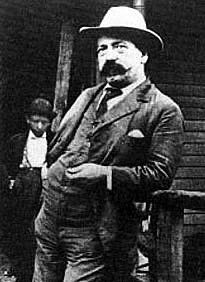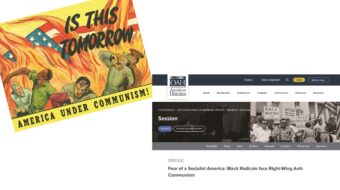
Gompers died December 13, 1924. He served as president of the American Federation of Labor from 1886 to 1894 and from 1895 to his death.
It has been claimed that to Samuel Gompers the American labor movement owes its structure and characteristic strategies.
Born in 1850 into a Jewish family in London, Gompers began making cigars alongside his father at the age of 10. In 1863, the entire family immigrated to New York City, settling into a tenement apartment on Houston Street. In 1864, he joined Local 15 of the United Cigar Makers. At his job and in his local union, Gompers met with a group of older émigré socialists and labor reformers whom he would always credit for his commitment to trade unionism as the essential vehicle for bringing about social reform.
In 1875, Gompers was elected president of the reorganized Local 144 of the Cigar Makers’ International Union. In the 1880s, Gompers was instrumental in establishing the Federation of Organized Trades and Labor Unions. When the FOTLU re-organized in 1886 as the American Federation of Labor, Gompers was elected its first president, a position he held for nearly 40 years.
As a local and national labor leader, Gompers sought to build the labor movement into a force powerful enough to transform the economic, social and political status of America’s workers.
Like other progressives in his era, he advocated craft or trades unionism, which restricted union membership to wage earners and grouped workers into locals based on their trade or craft identification. At the time, many considered it a step forward, but this approach contrasted with the effort of many in the Knights of Labor to organize general, community-based organizations open to wage earners as well as others, including employers. And it contrasted sharply with the “one big union” philosophy of the Industrial Workers of the World.
At first, Gompers believed in a pure-and-simple unionism that focused primarily on economic rather than political reform as the best way of securing workers’ rights and welfare. Gompers’s faith in legislative reform was dashed in the 1880s after the New York Supreme Court overturned two laws regulating tenement production of cigars that he had helped pass.
When political action was necessary, Gompers argued that the best way of enhancing the political leverage of labor was to articulate an independent political agenda, seek the endorsement of existing political parties for the agenda and mobilize members to vote for those supporting labor’s agenda.
With his election as president of the AFL in 1886, he immediately threw himself into the organization’s first big effort-a nationwide general strike on May 1, 1886- in support of an eight-hour workday.
Employers had long sought to use the nation’s new anti-trust laws as a legal basis for court-issued injunctions against strikes and boycotts. And in 1906, after nonunion employers sued the hatters’ union and each individual member for triple damages in compensation for the losses they had suffered in a union boycott, Gompers concluded that the movement had to seek legislative relief. The Danbury Hatters’ case, he wrote, “threatened the very existence of organized labor.” It was “of paramount importance that labor unions be specifically removed from the application of anti-trust law and that injunction use be defined and regulated.”
Unfortunately, like many social democrats and others, Gompers effectively supported U.S. involvement in World War I. Around the world many otherwise progressive forces supported their governments in what was an imperialist war.
During World War I, President Woodrow Wilson appointed Gompers to the Council of National Defense, where he helped mobilize labor support for the war. Ironically, Gompers also was crucial in convincing Wilson on a wartime labor policy that for the first time in U.S. history explicitly articulated government support for independent trade unions and collective bargaining.
Wilson appointed Gompers to the Commission on International Labor Legislation at the Versailles Peace Conference, where Gompers helped create what would become the International Labor Organization (ILO).
Gompers died in December 1924 in San Antonio, Texas, where he had been rushed after falling ill in Mexico City while attending the inauguration of the new president of Mexico, Plutarco Elías Calles.
“What does labor want? Gompers said, “We want more school houses and less jails; more books and less arsenals; more learning and less vice; more constant work and less crime; more leisure and less greed; more justice and less revenge; in fact more of the opportunities to cultivate our better natures, to make manhood more noble, womanhood more beautiful and childhood more happy and bright.”
Contributing to this story: The Samuel Gompers papers and AFL-CIO
Photo of Gompers, University of Maryland












Comments